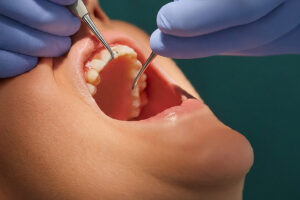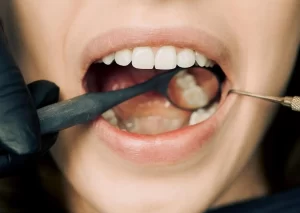Tooth Extraction Healing White stuff. What Is That?

When you undergo a tooth extraction, the healing process that follows is pretty straightforward. One common occurrence during this period is the appearance of a white or slightly yellowish substance in the area where the tooth was removed.
If you’ve noticed this “white stuff” and are concerned about what it means for your healing process, you’re not alone. Many of my patients have asked us about the white stuff appearing in the dental socket.
This article will demystify the nature of this substance, explaining why it’s actually a normal and expected part of the healing journey following a tooth extraction.
Table of Contents
What is the White Stuff After Tooth Extraction?
The white stuff that appears in the site of a tooth extraction is commonly a part of the natural healing process. It is primarily granulation tissue, which is a type of tissue that forms during the healing of a wound.
This tissue is rich in collagen and blood vessels, playing a crucial role in healing by protecting the wound, preventing infection, and allowing new tissue to grow.
In the context of a tooth extraction site, this white or slightly yellowish material may initially seem alarming, but it’s actually a good sign. It indicates that the body is effectively working to repair the area.
This granulation tissue eventually matures and is replaced by normal gum tissue as the healing progresses.
It’s important to differentiate this normal healing tissue from signs of infection, such as pus, which would typically be accompanied by other symptoms including severe pain, swelling, and possibly a bad odor.
If the area becomes increasingly painful or shows signs of infection, speak to your dentist, so that you can treat a potential tooth infection.
How to know what the white tissue in the tooth socket is?
The white tissue you observe in a tooth socket after an extraction is generally a sign of the normal healing process. This white or slightly yellowish area is often composed of granulation tissue, which serves as the foundation for the new tissue to grow.
Recognizing this as a normal part of healing is important, but there are signs to watch for to ensure it’s not something that requires medical attention:
Normal Healing Tissue
Typically appears within a few days after the extraction and might cover the extraction site. It’s soft, slightly granular in texture, and may have a white or yellowish hue. This indicates the body is healing properly, and the site is well on its way to recovery.
Signs of Infection
If the white tissue is accompanied by severe pain, foul odor, fever, or unusual discharge, it could be a sign of infection rather than normal healing tissue. Infections may require treatment, such as antibiotics, so it’s important to contact your dentist if these symptoms arise.
Dry Socket
Another condition to be aware of is dry socket (alveolar osteitis), which occurs if the blood clot that forms in the tooth socket after an extraction is dislodged or dissolves before the wound has healed.
Unlike normal granulation tissue, a dry socket often presents with intense pain and a visible bone in the socket, without the presence of white tissue covering the area. This condition requires immediate dental care.
If you’re uncertain about the appearance of the tissue in your tooth socket or if you’re experiencing symptoms that concern you, it’s always best to consult with your dentist.
When the White Stuff is NOT a Good Sign
The appearance of white stuff in the tooth socket after an extraction is often a normal part of the healing process, usually indicating the formation of granulation tissue or a protective clot.
There are instances when this white appearance might signal a complication or the need for further attention. Recognizing these signs can help ensure timely interventions and prevent complications.
Here’s when the white stuff might not be a good sign:
- Persistent pain: While some discomfort is normal after an extraction, if the pain persists or worsens over time instead of gradually improving, it might indicate an issue such as infection or dry socket.
- Spreading redness or swelling: If the area around the extraction site becomes increasingly red or swollen, and this spreads rather than diminishes, it could be a sign of infection.
- Foul odor or taste: A bad odor or taste coming from the extraction site is a warning sign of infection or necrotic (dead) tissue.
- Fever or general malaise: Developing a fever or feeling generally unwell in the days following an extraction could indicate an infection requiring medical attention.
- Excessive bleeding: While some bleeding is expected immediately after extraction, if it continues heavily beyond the first 24 hours, it might suggest that the clot has been dislodged or has not formed properly.
- Visible bone or large gaps: If you can see bone within the socket or notice a significant gap where the white tissue should be forming, it might suggest a problem with the healing process, such as dry socket.
What Are the Signs of Infection?
Signs of infection following a tooth extraction or any oral surgery can vary in severity, but it’s good to recognize them early to prevent further complications.
Here are the common signs of infection:
- Increased pain: Pain that intensifies, persists beyond the expected healing period, or doesn’t respond to pain medication could indicate an infection.
- Swelling: Some swelling is normal after an extraction, but if it worsens over time or doesn’t start to subside after the first few days, it may be a sign of infection.
- Redness: An increase in redness around the extraction site or spreading away from the site can be a sign of spreading infection.
- Warmth: The area around the extraction site feels unusually warm or hot compared to the rest of your mouth or face.
- Pus or discharge: The presence of yellow or white pus, or any other unusual discharge from the extraction site, is a clear indicator of infection.
- Foul odor or taste: A bad taste in your mouth or a foul odor emanating from the extraction site can be due to an infection.
- Fever: Developing a fever after a tooth extraction is a systemic sign of infection, indicating that your body is fighting off an infection.
- Swollen lymph nodes: The lymph nodes near your jaw or neck may become swollen and tender in response to an infection in the area of the extraction site.
- Difficulty opening your mouth: If an infection worsens, it might lead to stiffness and difficulty in opening your mouth, often due to the swelling and pain in the affected area.
If any of these symptoms are present, see your dentist. I had patients ask me if a tooth infection can kill you, but let’s not get there. In the majority of cases, if you go to the dentist when your symptoms worsen, after a tooth extraction, you’ll be just fine. Don’t wait it out, seek help.
And if you’re asking yourself: can I use Nitrofurantoin for tooth infection?, the answer is no, there are better options for that. Again, let your dentist help you and never self-medicate.
FAQ on Tooth Extraction Healing White stuff
How do I know if my tooth extraction is healing properly?
To know if your tooth extraction is healing properly, look for gradual improvement over days, including reduced pain, minimal swelling, and the formation of a whitish or granulation tissue in the socket. Absence of severe pain, foul odor, excessive bleeding, or spreading redness are good signs. The presence of a blood clot in the socket without dislodgement indicates proper healing. If healing progresses without these complications, it’s likely your extraction site is healing as expected.
What happens if granulation tissue falls out?
If granulation tissue falls out from a tooth extraction site, it could potentially delay healing or increase the risk of infection, as granulation tissue plays a crucial role in the healing process by protecting the wound and aiding in tissue regeneration. The body is capable of producing more tissue to continue the healing process.
How long does granulation tissue last after tooth extraction?
Granulation tissue typically forms within the first few days after a tooth extraction and is an essential part of the healing process. This tissue usually lasts until the wound has sufficiently healed and is gradually replaced by normal gum tissue. This process can take several weeks, often around 3 to 4 weeks, but the exact timeline can vary depending on the individual’s healing capacity, the complexity of the tooth extraction, and adherence to post-operative care instructions.
Fact Checked
Our dedicated team rigorously evaluates every article and guide to ensure the information is factual, up-to-date, and free of bias.
Updated Regularly
We update our articles and reviews regularly to ensure you have access to the latest data in the dental industry.
The content on Dental3DU’s blog is intended for educational purposes only. This information should not be relied upon as professional medical counsel. Be sure to always consult with your dentist about the dangers and benefits of any medication, treatment or procedure.







